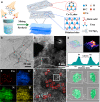Integrating single-cobalt-site and electric field of boron nitride in dechlorination electrocatalysts by bioinspired design
- PMID: 33436610
- PMCID: PMC7803959
- DOI: 10.1038/s41467-020-20619-w
Integrating single-cobalt-site and electric field of boron nitride in dechlorination electrocatalysts by bioinspired design
Abstract
The construction of enzyme-inspired artificial catalysts with enzyme-like active sites and microenvironment remains a great challenge. Herein, we report a single-atomic-site Co catalyst supported by carbon doped boron nitride (BCN) with locally polarized B-N bonds (Co SAs/BCN) to simulate the reductive dehalogenases. Density functional theory analysis suggests that the BCN supports, featured with ionic characteristics, provide additional electric field effect compared with graphitic carbon or N-doped carbon (CN), which could facilitate the adsorption of polarized organochlorides. Consistent with the theoretical results, the Co SAs/BCN catalyst delivers a high activity with nearly complete dechlorination (~98%) at a potential of -0.9 V versus Ag/AgCl for chloramphenicol (CAP), showing that the rate constant (k) contributed by unit mass of metal (k/ratio) is 4 and 19 times more active than those of the Co SAs/CN and state-of-the-art Pd/C catalyst, respectively. We show that Co single atoms coupled with BCN host exhibit high stability and selectivity in CAP dechlorination and suppress the competing hydrogen evolution reaction, endowing the Co SAs/BCN as a candidate for sustainable conversion of organic chloride.
Conflict of interest statement
The authors declare no competing interests.
Figures




Similar articles
-
Enhancing photocatalytic hydrogen evolution of carbon nitride through high-valent cobalt active sites in cobalt sulfide co-catalyst.J Colloid Interface Sci. 2025 Apr;683(Pt 2):546-554. doi: 10.1016/j.jcis.2024.12.198. Epub 2024 Dec 26. J Colloid Interface Sci. 2025. PMID: 39740570
-
Designing cobalt-nickel dual-atoms on boron, nitrogen-codoped carbon nanotubes for carbon dioxide electroreduction to syngas.J Colloid Interface Sci. 2025 Apr;683(Pt 1):446-456. doi: 10.1016/j.jcis.2024.12.096. Epub 2024 Dec 16. J Colloid Interface Sci. 2025. PMID: 39693882
-
Rational Modulation of Single Atom Coordination Microenvironments in a BCN Monolayer for Multifunctional Electrocatalysis.Small. 2023 Oct;19(42):e2302429. doi: 10.1002/smll.202302429. Epub 2023 Jul 11. Small. 2023. PMID: 37433972
-
Density Functional Theory Study of Aspirin Adsorption on BCN Sheets and their Hydrogen Evolution Reaction Activity: a Comparative Study with Graphene and Hexagonal Boron Nitride.Chemphyschem. 2019 Mar 4;20(5):687-694. doi: 10.1002/cphc.201801173. Epub 2019 Feb 12. Chemphyschem. 2019. PMID: 30623536
-
Electronic and Structural Engineering of Carbon-Based Metal-Free Electrocatalysts for Water Splitting.Adv Mater. 2019 Mar;31(13):e1803625. doi: 10.1002/adma.201803625. Epub 2018 Oct 1. Adv Mater. 2019. PMID: 30276904 Review.
Cited by
-
Burning question: Rethinking organohalide degradation strategy for bioremediation applications.Microb Biotechnol. 2024 Aug;17(8):e14539. doi: 10.1111/1751-7915.14539. Microb Biotechnol. 2024. PMID: 39075849 Free PMC article. Review.
-
Ampere-level current density ammonia electrochemical synthesis using CuCo nanosheets simulating nitrite reductase bifunctional nature.Nat Commun. 2022 Dec 22;13(1):7899. doi: 10.1038/s41467-022-35533-6. Nat Commun. 2022. PMID: 36550156 Free PMC article.
-
Optimization of Dechlorination Experiment Design Using Lightweight Deep Learning Model.Comput Intell Neurosci. 2022 Jun 25;2022:1623462. doi: 10.1155/2022/1623462. eCollection 2022. Comput Intell Neurosci. 2022. PMID: 35789615 Free PMC article.
-
Strong ferromagnetism of g-C3N4 achieved by atomic manipulation.Nat Commun. 2023 Apr 20;14(1):2278. doi: 10.1038/s41467-023-38012-8. Nat Commun. 2023. PMID: 37080974 Free PMC article.
-
Mimicking reductive dehalogenases for efficient electrocatalytic water dechlorination.Nat Commun. 2023 Aug 23;14(1):5134. doi: 10.1038/s41467-023-40906-6. Nat Commun. 2023. PMID: 37612275 Free PMC article.
References
Publication types
LinkOut - more resources
Full Text Sources
Other Literature Sources
Miscellaneous

